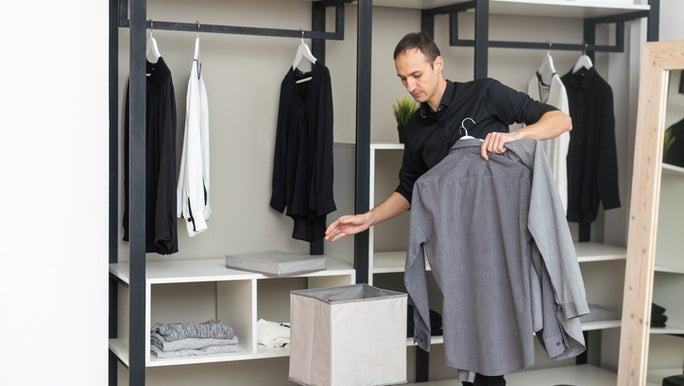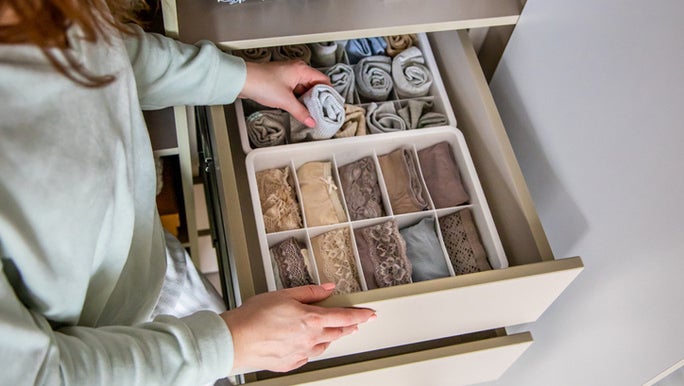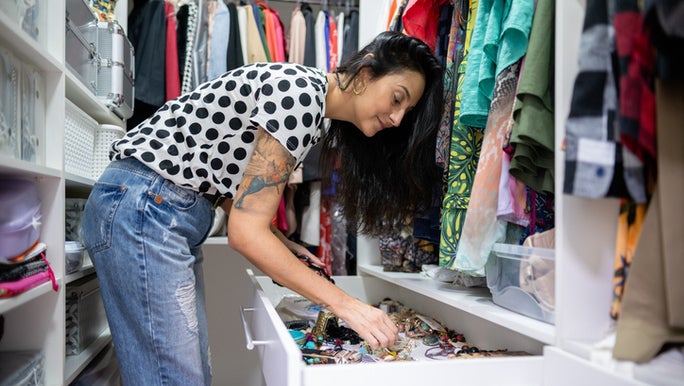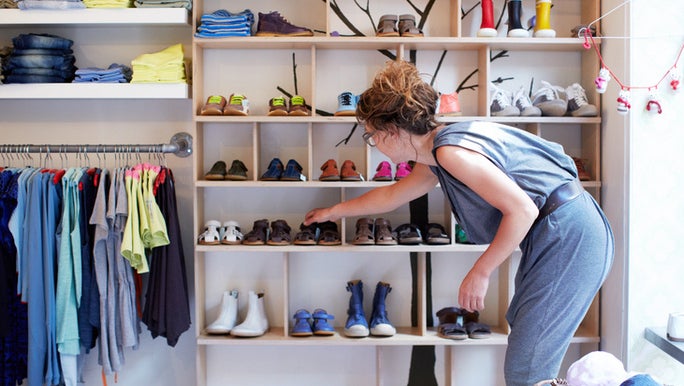Key Points
- Be prepared to let go of clothes you no longer wear.
- Organise your wardrobe according to category and colour.
- Invest in shelving, hanging organisers and storage solutions.
A smooth day begins with a visit to your wardrobe and picking out your favourite outfit. But what happens if your clothes are jammed into drawers, fallen on the floor or in piles near the bed? Clutter may overwhelm your brain and make a simple ritual like getting dressed stressful and time-consuming. Thankfully, organising your wardrobe doesn’t need to be as daunting as it may seem.
Organising your wardrobe is an expression of self-care. Beyond finding what you need in a flash and minimising morning stress, you’ll be able to extend the longevity of your wardrobe and start your day feeling good.
In this article, we’ll look at some of the best ways to organise your wardrobe, from decluttering those miscellaneous mounds to finding storage solutions that you’ll love.
How do you declutter a wardrobe fast?
Step 1. Begin with an objective eye: Are you attached to an old pair of jeans that no longer fit? Here’s a rule of thumb to make saying goodbye easier.
If your clothes are the wrong size or you haven’t worn them in a year, donate them to someone who needs the clothing boost. If they’re in poor condition, unpick the seams and repurpose into cleaning rags. If you’re in two minds about something, ask yourself whether you can live without it – and be honest!
Step 2: Divide and conquer. Pull everything out of the wardrobe and create three piles on the bed for items you will ‘keep’, ‘donate’ and ‘toss’. You may like to add a fourth category for items you want to sell, but resist the urge to have a fifth ‘maybe’ pile. This is about decluttering your wardrobe fast, so be prepared to make tough calls. Populate the ‘keep’ pile if you love it and still wear it. If it’s in good condition, but you no longer wear it or can live without it, donate it or sell it. Anything that’s stained, torn or beyond repair should be tossed or repurposed.
Step 3: Clean and reorganise. Before you return anything to your wardrobe, wipe down shelves and make sure drawers are clean. Once you pack your ‘donate’, ‘sell’ and ‘toss’ piles into boxes or bags, it’s time to hang or fold the clothes and accessories you’re keeping. Now’s the time for a strategy refresh. If you usually just hang, fold or squish everything in without a system, consider trying something new. You can hang or fold items according to colours, seasons or functions.
Top tips for wardrobe decluttering
- Be honest.
- Be ruthless.
- Make quick decisions.
- Set a timer.
- Don’t keep anything ‘just in case’.

Always hang business suits and shirts to avoid creasing
Smart wardrobe organisation ideas
Once you’ve decluttered your wardrobe, it’s time to start organising.
1. Group your clothes and accessories by category.
For example, keep all your pants together, all your shirts together and all your jackets together. This method makes it easier to see what you have and what you need to buy to complete your wardrobe.
2. Arrange your clothes by colour within each category.
Not only does it create an Instagram-worthy wardrobe to admire each day, but you’ll also be able to see if you have any colour gaps.
3. Maximise bag storage.
Daily bags and backpacks can be stored on shelves at eye level or hung on over-the-door hooks. Occasional bags can go on a high shelf, and shoes can be stored on shoe racks on the wardrobe floor if you don’t have enough shelf space.
What to hang and what to fold
Depending on the fabric and shape of the garment, some items should be hung and others folded in a drawer.
Fold: Anything that might lose shape when hung, such as knitwear. Clothes that aren’t practical to hang due to their size or shape should also be folded, such as activewear, shorts, T-shirts and scarves.
Hang: Always hang work suits, business shirts, dresses, blouses and linen to avoid creasing.
Jeans are the ultimate versatile garment both in and out of the wardrobe, so they can be hung or folded according to personal preference.
Why you should invest in good hangers
Good hangers may help to increase the longevity of your clothing. If you’re harbouring wire hangers in your wardrobe, consider replacing them. Not only do they buckle under the weight of heavy garments, but they can also leave unsightly stretch marks on your clothes. If you’re short on space, consider slimline velvet hangers. These essentials prevent garments from slipping, while good quality wooden hangers are sturdy, ideal for heavier clothing like jackets, suits and jeans.

Storage boxes or baskets and drawer dividers can help to keep your wardrobe organised
How to keep your wardrobe organised year-round
Keep your wardrobe organised year-round and declutter seasonally. At the start of each season, go through your clothes and accessories. Pack winter coats and jackets away during spring and summer, and pack away swimmers and other summer clothes you won’t wear during the colder months.
Store your out-of-season clothes on a high shelf in your wardrobe, or make use of under-bed storage or a spare closet. Vacuum-sealed bags are also a great option if you’re short on space, given that they shrink everything down, so you only need a fraction of the space.
Invest in storage and space-saving solutions
If you’re struggling to find space in your wardrobe, consider using space-saving solutions such as hangers that can hold multiple items or hanging organisers that can fit over the back of your wardrobe door, as well as hooks and shoe racks.
Buy storage boxes or baskets to help keep your wardrobe organised, and label them according to their contents, e.g. activewear, T-shirts, shorts and pyjamas.
If your wardrobe has drawers, drawer dividers can help keep things more organised and are great for smaller items like socks and underwear. If your wardrobe doesn’t contain drawers or shelves, consider buying a chest of drawers to store items that can’t be hung. Hanging fabric shelf organisers are a cost-effective alternative. Fold your clothes neatly and consistently inside drawers so you can easily see everything.

Keeping your wardrobe organised and decluttered saves time and may help reduce stress
Declutter your wardrobe and reap the rewards
Having an organised and decluttered wardrobe saves time because you’ll always know where everything is. It can also save money because you’re less likely to buy duplicates or items you don’t need when everything is visible and in good condition.
Getting dressed is a daily task, so make it as pleasant and stress-free as possible by organising your wardrobe. It will help you keep a calm and uncluttered mind and set you up for a great day.
Related:



